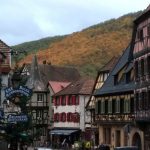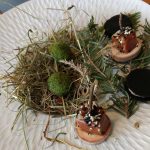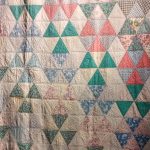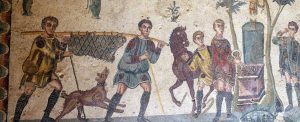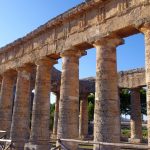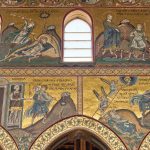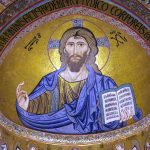To download a printable PDF version click on this link E2E2016no4.pdf (six A4 pages)
There are links to fuller sets of photographs in the text and on some photographs
together with a full set of the Sicily visit photographs
The swimming pool was on the E2E patio and the damsons dropping from the orchard trees in the last episode. Now, at the start of December, the pool has long been deflated and the pot plants, swing seat, garden benches, garden ornaments and trickle watering pipes are stowed away in a barn, protected from the heavy frosts sparkling on the fields. The winter tyres are on the cars, the summer mud and autumn leaves cleared out of the drainage channels, the oil storage tank re-filled and the underfloor heating comforting indoors. So we could withstand being snowed in. But as yet there is no snow.
On the radio up in the attic there is discussion of pantomimes – Aladdin, Jack in the Beanstalk, Cinderella and Mother Goose – and the mince pies have been opened (though not the sherry, which is rarely sold in France). Tonight Saint Nicholas, resplendent in his purple bishop’s robes, will follow a long and colourful procession of floats and dancers through the streets of Saint Dié, before disappearing with a flourish, door bang and fireworks into the Cathedral till next year. We shall probably give the procession a miss, as there’s a lot of standing around waiting and evening temperatures have been sub-zero. However next weekend, having been unaccountably delayed for a week, a less dignified Saint Nicholas will manifest in Entre-deux-Eaux, together with the sinister Père Fouettard, to check if the village children have been good all year, before distributing sweets and being serenaded by the children. This is a warmer, homely event in the village hall, so there may well be English observers.
As for the mince pies: this year Helen, sad that the Sainte Marguerite pensioners’ Friday Scrabble has diminished to a fortnightly event, has joined the group which meets on the alternate Fridays to do number and word puzzles to keep the ageing brains active. Their sessions are more sociable, starting with funny anecdotes round the table, moving on to exercises and finishing up with cakes and drinks. Helen volunteered cakes for the first December meeting and the group gamely agreed to try out something foreign. But what? After some thought when we were recently in the UK, we stocked up on mince pies and Bakewell tarts. Most people started, gingerly, with a mince pie, with one of the more elegant, sophisticated ladies voicing everyone’s uncertainty about the filling. “Dried fruits” puzzled them until someone pronounced it more like marmalade than anything else they knew. The icing on top of the Bakewell tarts was a mistake though, as it was far too sweet for French tastes and overwhelmed the almond flavour which would have been familiar to them from galette des rois. Helen’s opening anecdote was probably better received than the tarts: the one most of you will already have heard about incomprehensible English accents and our neighbour being horrified when asked if he’d killed a sanglier (boar), but hearing it as anglais (English man). The ensuing discussion of accents produced another story involving a Breton in a Saint Dié bakery trying to order a bougelov having earlier tasted the Alsace kougelhof cake delicacy.
Kaysersberg is a calendar-picturesque Alsace walled village and even in the damp mist a couple of weeks ago the hills above were golden with autumn leaves. John dislikes going there as he considers it is always crowded with visitors and its quaintness is artificial (having chosen, after the war, to rebuild houses to look just as they used to, with fake beams, timber and carvings concealing the concrete). However after a very good meal in l’Alchemille, a recently opened restaurant on the outskirts, he agreed to a short stroll around the old town. For once the streets were almost deserted and the structurally unnecessary timbered facades and overhanging eves were being decked with green branches and red berries in readiness for the forthcoming Christmas Market and its crowded car parks, mulled wine, traffic wardens, spice bread, wooden stalls, shuffling throngs and, maybe, armed police this year, like Strasbourg. Even the shops were looking sleepy, though the bakery window was full of anticipatory kougelhof and berawecka. Berawecka is a very expensive Alsace Christmas treat made of dried fruit, spice and a dash of kirsch cherry liqueur. It is sold in small slices and, as you would guess, tastes very like the filling of mince pies.
We were glad, however, that the restaurant menu at l’Alchemille had still been very autumnal. Autumn being the time when the pigs are killed, the menu-of-the-day had pièce de cochon gras d’Alsace as its main course. However, another menu with its equally autumnal ingredients caught our eyes with mushrooms “from our mountains”, chestnut and celery in the starter. The surprise pre-starters were served first and looked so artistic. On a bed of straw nestled two green conkers, edged with beige mushrooms and dark brown rounds on a fir twig. We were formally introduced to this creativity as parsley crunchy cakes, terrine on a stick and cinder biscuits with pate filling. Wow! And delicious! The creamy mushroom soup starter tasted wonderful and the chicken main course a worthy successor. And then an autumnal dessert of caramelised apple. With the coffee came colourful discs of beetroot, carrot and apple and little blackberry tarts. No wonder John could affably face even the quaintness of the main shopping street afterwards. Perhaps the wine also helped.
Having have been in the UK more frequently this year, we have missed quite a few of the regular autumn events here, like the International Festival of Geography and some of our favourite flea markets. However we were here in September for the Patchwork Festival in Sainte-Marie-aux Mines and surrounding villages. Each year’s competition quilts are artistic creations, but the quilts hanging in the church in Sainte-Croix-aux-Mines were very basic designs and looked more hastily stitched. But they had a fascinating story.
During the war a Dutch woman, An, and her pastor husband were in the Resistance and sheltered many refugees. At the end of the war all the bedding was burned as it was vermin infested. But then, in 1945, came Ukrainian refugees fleeing Russian persecution. The American and Canadian Mennonites had been canning food and sewing quilts to aid the people of Holland post-war and immediately supplied quilts, which were unfamiliar to the Dutch (but part of the Ukrainians’ heritage so they piled them up happily for warmth). When the Ukrainians departed on a ship to Patagonia, where farmers were required, An folded up the quilts and kept them. Years later in 1980 a young American, Lynn, living with her Palestinian husband and child in Holland, spent a weekend in An’s farmhouse and was amazed and nostalgic seeing the Mennonite quilts on all the beds. An said they weren’t hers to sell but offered to give her one. Lyn, knowing their value, felt she couldn’t accept such an expensive gift from a stranger. However, 10 years later, when patchwork and its history were becoming popular in Holland, she asked An if she could exhibit them in their American bookshops in Amsterdam and The Hague at Thanksgiving and their story started to emerge. Eventually Lynn wrote an interesting book called “Passing on the Comfort: The War, the Quilts and the Women Who Made a Difference”. Helen is happy to lend her copy to anyone interested.
Around the same time, the oldies of E2E had their September cake and champagne social get-together. Helen took her walking boots as the former mayor often leads a walk for the more active members, usually about six or seven. This time he led us up the track near our house, which we know rather well, then on and ever on. It was a longer walk than many people wanted; one had to turn back, a lift had to be flagged down for another, and the rest of us got back an hour after the cake and champagne were served. There was considerable grumbling. The ex-Mayor was not present at the November meeting and everyone seemed relieved to relax and to play Scrabble and Rummikub instead – and be at the front of the cream cake queue.
We seem to watch a lot of crime series on TV these days, especially during the long winter nights. But the one with the best scenery is definitely Montalbano, which has for a long time been enticing us to visit Sicily, as has the lavishly illustrated book we picked up in an Amnesty Book sale in Saint Dié. And there are flights from Basel to Catania. So we flew to Catania at the end of September and picked up a hire car at the airport. But instead of heading down the coast to Montalbano-land we drove inland. We spent the first night in a B&B outside Piazza Amerina which did a wonderful breakfast spread at which all the guests sat sociably round the laden table exchanging information and tips.
We were well placed to arrive at the nearby palatial Roman villa before all the coach tours, so could gaze for as long as we liked on the amazing mosaic floors from the walkways at first floor level. Each room was decorated very differently, our favourite being a woodland hunting scene to which we returned. There was a more spectacular long floor showing exotic mosaic animals being captured and loaded onto ships, and the one shown on all the posters of “dancing girls”, but the rural scene was so delicate and flowing.
By mid-day it was hot, so we drove to Aidone and looked round the cool little museum in a former Capuchin monastery which displayed objects from the excavations of the Greek city of Morgantina. Montalbano was not forgotten, however, as we revived ourselves afterwards with cold drinks and our first (and best) taste of the detective’s favourite arancini risotto balls, before exploring the almost deserted Morgantina excavations. This hilltop site was less spectacular than temple sites we were to see later, but its ruins so extensive, with its houses, roads, agora, workshops, amphitheatre, bath-house, granary and sanctuaries, that the sun was going down when we left.
The next day we took a country route towards the south coast and the temples of Agrigento. We did wonder about the meaning of a temporary road sign but were many kilometres further on when its meaning became apparent: boulders deliberately blocked the junction with the road we wanted to be on next. It was a weary return and diversion (un-signposted after the first turn off, then blocked by goats). We were so grateful for our satnav but at least we saw plenty of the wild flowers and changing land use before reaching the more arid coastal landscape where our B&B, the Garden Cactus, rejoiced in an enthusiast’s collection of thousands of cacti. That evening it rained, so our next day exploring the famous and popular Greek temples of Agrigento was unpleasantly humid on the exposed temple ridge.
Odd memories of the next day’s drive westwards along the coast, with John’s hacking cough and cold troubling him, are of a disappointingly scraggy beach, a lonely old man accosting us verbosely in good English in front of one of the gateways to Sciacca old town, and an elegant country hotel where a dish of grapes and a peach was offered as Helen reclined on a chaise longue reading.
In the late afternoon light the following day the Doric temple at Segesta looked magnificent and we caught the last shuttle bus up to the amphitheatre at the top of the hill with its spectacular view.
We spent our most memorable two days, despite John’s painful chest and fatigue, in Monreale with its Norman cathedral and pleasant town.
The cathedral glittered with mosaic Bible stories running in strip cartoon bands on a gold background right round the inside walls of the cathedral, with the magnificent golden Christ Pantocrator of the apse dominating all. More Bible stories as well as intricate plants, mythological beasts, acrobats and archers embellished the capitals of the marble columns supporting the Arab arches of the cloisters. Outside, seen from the narrow streets of the Jewish quarter, the flamboyant Arabic external decoration of the apse was striking.
After Cefalu on the coast, whose even earlier cathedral mosaics, apart from the Christ Pantocrator, were disappointing after Monreale, we headed inland again to the hilltop villages and towns. In Castelbuono we enjoyed the museum in the castle and the rather crude frescoes in the damp church crypt, and a cheap cafe in Nicosia. The wooded scenery was attractive but then the narrow road began to disintegrate and John had to navigate craters for many kilometres. To add to the atmosphere, Etna smoked dark but subdued ahead of us; and as we got nearer, the fertile orchards were blackened by lava flow, the winding country lanes were edged with black walls and the houses looked sinister with their black stones. Back in Catania the buildings and shabby streets were also a depressing black, but the vibrant street fish market and vegetable market added plenty of colour.
Despite not doing everything we’d planned in Sicily, we had a memorable twelve days there. We then had three days back in E2E, before setting out for the UK, which gave time to get the washing done and the car loaded with extra chairs, cooking equipment and crockery, as we planned to celebrate John’s 70th birthday in our considerably smaller (and relatively less well-equipped) house in Letchworth.
It was Jacob’s half term, and he helped us prepare the house and garden and food for the party, in between playing some of his favourite games. It was a shame he wasn’t with us on the Saturday as he would have enjoyed helping Alistair put up his two gazebos in the garden to form a spacious food tent. But he was back on the Sunday with Farrah, Rachel and Toby to join all the guests sampling the spread (thank-you Ann and Jessica for all the delicious extras!) laid out in the gazebos. And the day was even warm enough (just about) for some people to sit outside and others to undertake the Letchworth quiz. It was a good celebration and catch up with family and old friends. Ann and Derek came back for dinner on Wednesday, John’s actual birthday. And on the Friday we met up with Jessica and Mark for an amazing nine course lunch at The Clove Club in Shoreditch. So it was a lovely week.
The following week we had an enjoyable day in Cambridge (some good book purchases!) and on the Thursday drove up to Nottingham (another convivial meal, this time Indian, with Leila, John and Wendy). From there we drove up to the Lake District to meet up with the Train Gang. We all gathered at Sue and Hugh’s Old Schoolhouse for honey-chicken on the Friday evening, and it was good to include most of the husbands for the first time; even the neurotic and fearful (abused) dog coped with the gang by dint of watching the clock timer ticking loudly. The autumn colours were glorious as the gang drove to Patterdale church to see the plaque to the fifth member who died a couple of years ago. And in the evening we went back to a pub the gang had enjoyed a few years back.
The weather was not so good the next day when Jessica, John and Helen climbed up Cat Bells and Shelagh and Melvyn returned to Patterdale, but the hills were purple with heather and, when the rain clouds lifted, snow could be seen on the top of Skiddaw and Helvelyn.
On the way back from seeing the Traingang, we stopped to have lunch with Ann and Michael at the Old Hall in Sandbach (wonderful building but standard pub food). They had rented our farmhouse in the early days, and returned several times to dog-sit for our American friend Nicola. So it was good to catch up with them. And there was another link to that era when we returned to E2E a few days later; an e-mail from Nicola announced the death of Godiva, the last of the cats that Nicola had adopted in 1997 after other farmhouse tenants had told her about the four kittens abandoned by a wild cat in a woodpile below our vegetable patch. Two of those peasant kittens had later moved to a Paris flat and two had gone to the south coast with Nicola and her dogs, far from their humble origins.
Since those busy weeks in Sicily and in the UK, everyday life has seemed calmer back in E2E. The most frequent vehicles on our road are tractors bringing bales of hay down to the cowshed. So it was a surprise the other day to hear a gaggle of girls running after a car, waving something in their hands. They turned out to be some of the Saulcy baton-twirlers selling their calendar – probably more colourful than that of the firemen or rubbish collectors, and a definite indication of the fast-approaching end of the year. No doubt the postman will knock soon with his calendars. He will have to hurry, as only next week we hope to be re-packing the car and setting off for Christmas in Letchworth.
In the meantime, we hope you are enjoying all your December activities and preparations. Joyeuses fetes de fin d’année!

